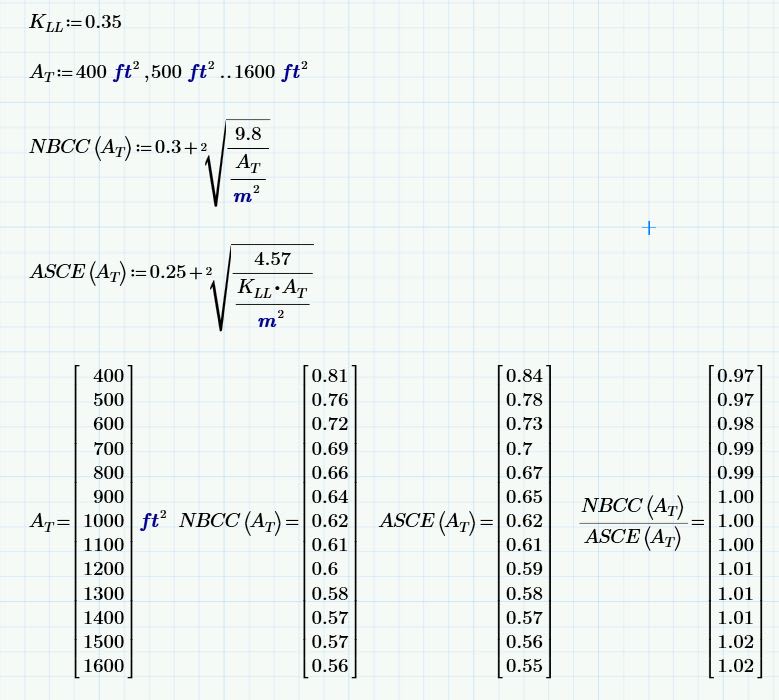DavitBek
Structural
- Aug 5, 2019
- 4
Hi All
Long time follower of the forum, and first time poster, as usually I find the answer to the question I have from posts in the past
I was looking to understand the acceptable procedure for reducing the live load on a concrete podium from wooden stories above. Specifically, a 6 story mixed use structure, a two story two way concrete podium (one underground garage, one commercial above), and four wooden stories residential sitting on top of the commercial level.
I am using a two stage analysis, designing the wooden stories separately, and superimposing the loads on a concrete podium.
Using that procedure, summing the forces in four wooden stories I would have a total of 180 lb/sqft (4x40lb/sqft+20lb/sqft) sitting on the concrete podium. And specifically 160 lb/sqft floor live load.
As you likely know, the ASCE 7-10 (Chapter 4.7) prescribed live load reduction is
L=Lo(.25+15/((KLL*AT)^.5))
L=reduced live load
Lo=unreduced live load
KLL=live load element factor (KLL=1 in the case of a slab)
AT=tributary area
(Max reduction allowed is L=0.4Lo)
I'm looking to reduce this 160lb/sqft floor live load in my design of the concrete podium, as all four stories will never be packed to capacity.
Specifically, what I am not sure of is what AT value to use.
Both in my office and on the forum I've found a lot of conflicting answers ranging from using the entire footprint of the wooden stories(16,000 sqft in this case), the area between four columns supporting the slab multiplied by the number of stories (30ft*30ft*4=3,600 sqft), and the area between four columns supporting the slab (30ft*30ft=900 sqft).
Needless to say, those three values produce wildly different reduction factors
16,000 sqft: L=.37Lo=.4Lo
3,600 sqft: L=.50Lo
900 sqft: L=.75Lo
In all past projects of this nature I have used a 25% reduction to be on the safe side, however it would nice to get a firm answer to this question and to know whether I am over designing, and if I would be okay using a 40% reduction factor recommended by the owner of a company- a very experienced and respected engineer.
Long time follower of the forum, and first time poster, as usually I find the answer to the question I have from posts in the past
I was looking to understand the acceptable procedure for reducing the live load on a concrete podium from wooden stories above. Specifically, a 6 story mixed use structure, a two story two way concrete podium (one underground garage, one commercial above), and four wooden stories residential sitting on top of the commercial level.
I am using a two stage analysis, designing the wooden stories separately, and superimposing the loads on a concrete podium.
Using that procedure, summing the forces in four wooden stories I would have a total of 180 lb/sqft (4x40lb/sqft+20lb/sqft) sitting on the concrete podium. And specifically 160 lb/sqft floor live load.
As you likely know, the ASCE 7-10 (Chapter 4.7) prescribed live load reduction is
L=Lo(.25+15/((KLL*AT)^.5))
L=reduced live load
Lo=unreduced live load
KLL=live load element factor (KLL=1 in the case of a slab)
AT=tributary area
(Max reduction allowed is L=0.4Lo)
I'm looking to reduce this 160lb/sqft floor live load in my design of the concrete podium, as all four stories will never be packed to capacity.
Specifically, what I am not sure of is what AT value to use.
Both in my office and on the forum I've found a lot of conflicting answers ranging from using the entire footprint of the wooden stories(16,000 sqft in this case), the area between four columns supporting the slab multiplied by the number of stories (30ft*30ft*4=3,600 sqft), and the area between four columns supporting the slab (30ft*30ft=900 sqft).
Needless to say, those three values produce wildly different reduction factors
16,000 sqft: L=.37Lo=.4Lo
3,600 sqft: L=.50Lo
900 sqft: L=.75Lo
In all past projects of this nature I have used a 25% reduction to be on the safe side, however it would nice to get a firm answer to this question and to know whether I am over designing, and if I would be okay using a 40% reduction factor recommended by the owner of a company- a very experienced and respected engineer.

